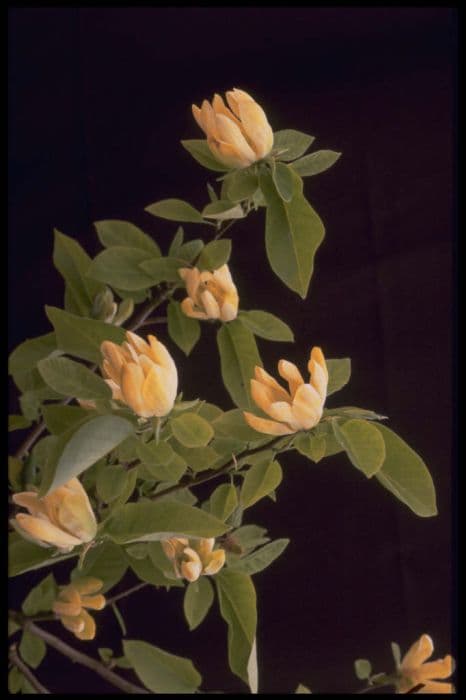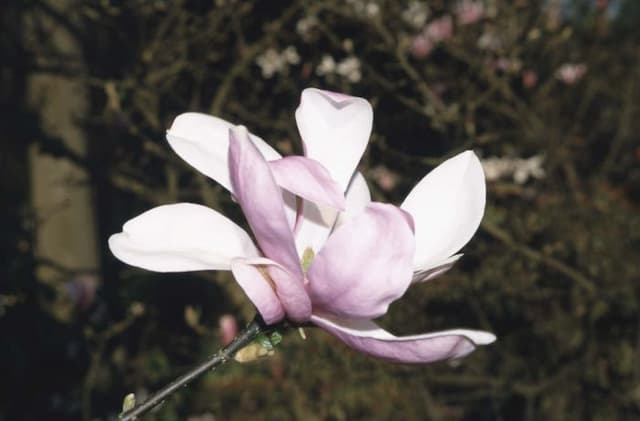Betty Magnolia Magnolia 'Betty'

ABOUT
Magnolia 'Betty' is a captivating plant known for its stunning flowers which are the centerpiece of its appearance. These blossoms are unique, with a tulip-like shape and a rich, purple-pink hue on the outside while revealing a paler, almost pearly-pink or white interior as they open. The petals are large and broad, with a silky texture that can catch the light, adding a luminous quality to the plant. Typically, Magnolia 'Betty' flowers emerge in the early to mid-spring, sometimes before the leaves, which increases their visual impact. After the flowering season, the glossy, dark green leaves take over, providing a dense canopy of foliage throughout the summer months. The leaves are oval to oblong with a smooth margin, and they have a leathery feel that endures well into the fall. As the seasons change, the foliage may turn to a golden bronze color, offering a warm, autumnal display. The overall structure of Magnolia 'Betty' is upright and branching, which may give it a somewhat pyramidal or rounded shape, creating an elegant silhouette in the landscape. This ornamental quality makes the Magnolia 'Betty' a favored choice for gardeners looking to add a striking visual element to their gardens. Its bold blooms, attractive leaves, and pleasant structure make it a standout specimen, irrespective of its size.
About this plant
 Names
NamesFamily
Magnoliaceae
Synonyms
Betty Magnolia, Betty Girl Magnolia
Common names
Magnolia 'Betty'
 Toxicity
ToxicityTo humans
Magnolia 'Betty' is not considered toxic to humans. There are no significant symptoms of poisoning associated with this plant since it is generally regarded as non-poisonous. However, consuming any part of the plant is not advisable as individual sensitivities can vary, and it is not intended for human consumption.
To pets
Magnolia 'Betty' is not known to be toxic to pets. It is generally safe around animals, and there are no common symptoms of poisoning shared by the majority of animals. However, as with any non-food plant, ingestion of large quantities may cause mild gastrointestinal upset in some pets due to the unusual material in their digestive system.
 Characteristics
CharacteristicsLife cycle
Perennials
Foliage type
Deciduous
Color of leaves
Green
Flower color
Purple-pink
Height
12-20 feet (3.6-6 meters)
Spread
10-15 feet (3-4.5 meters)
Plant type
Shrub
Hardiness zones
5-9
Native area
North America
Benefits
 General Benefits
General Benefits- Ornamental Value: Magnolia 'Betty' produces large, colorful, tulip-shaped flowers that add aesthetic appeal to gardens.
- Year-Round Interest: With flowers in spring and striking foliage that changes colors in the fall, this plant offers multiple seasons of visual interest.
- Wildlife Attraction: The blooms provide nectar for pollinators like bees and butterflies, while birds may feed on the seeds.
- Shade Provision: As a medium-sized tree, Magnolia 'Betty' can provide shade to garden spaces and help in cooling surrounding areas.
- Low Maintenance: This cultivar is known for being hardy and requiring minimal upkeep once established.
- Drought Tolerance: Once established, it has a good tolerance to drought, making it suitable for drier climates.
 Medical Properties
Medical PropertiesThis plant is not used for medical purposes.
 Air-purifying Qualities
Air-purifying QualitiesThis plant is not specifically known for air purifying qualities.
 Other Uses
Other Uses- Magnolia 'Betty' can be used as a natural dye source for fabrics, producing various shades of green or brown depending on the mordant used.
- The bark and flower buds of the Magnolia may be used in the craft of potpourri for its fragrance and texture.
- Wood from Magnolia 'Betty' trees is sometimes used in woodworking for creating small boxes or ornamental objects due to its fine grain.
- The leaves of Magnolia 'Betty' can be incorporated into a compost pile as they break down and enrich the soil with nutrients.
- Magnolia petals can be used in culinary decoration, for instance, crystallized with sugar to adorn cakes or desserts.
- Dried Magnolia leaves may be used as a natural mulch in gardens, providing soil protection and weed suppression.
- The strong branches of the Magnolia can be trimmed and used as natural stakes for supporting other plants in the garden.
- The seed pods from Magnolia 'Betty' can be used in floral arrangements or as focal points in wreaths and other dried flower crafts.
- In perfumery, the essence of Magnolia flowers is sometimes incorporated into fragrances for its sweet and exotic scent profile.
- Magnolia flowers are edible and can be used in salads or as a unique garnish to add both flavor and visual appeal to dishes.
Interesting Facts
 Feng Shui
Feng ShuiMagnolia is not used in Feng Shui practice.
 Zodiac Sign Compitability
Zodiac Sign CompitabilityMagnolia is not used in astrology practice.
 Plant Symbolism
Plant Symbolism- Perseverance: Magnolias are known for their durability and strength, able to withstand harsh conditions, making them a symbol of perseverance and endurance.
- Nobility: Often associated with the ancient Southern states, magnolias are seen as a symbol of elegance, dignity, and a noble spirit.
- Feminine Beauty: The magnolia's delicate and fragrant blossoms are commonly linked to the softness and beauty of femininity.
- Purity: The pristine white flowers of some magnolia varieties, including Magnolia 'Betty', are symbolic of purity and innocence.
- Longevity: Magnolias can live for many years, making them a representation of longevity and stability in cultures that prize these traits.
- Peace and Tranquility: The magnolia's smooth leaves and the serene appearance of its blooms can evoke feelings of calm and peace.
 Water
WaterFor a Magnolia 'Betty', also known as Betty Magnolia, the watering needs vary with soil type and weather conditions but a general rule is to aim for about 1 inch of water per week, whether from rainfall or manual watering. It's best to water deeply and infrequently to encourage the roots to grow deeper into the soil. During the growing season, this might mean watering with about 5 gallons per square yard every 7-10 days, depending on the climate and soil drainage. Always ensure the topsoil has dried out slightly before watering again to prevent overwatering. During the dormant winter season, reduce watering but do not allow the roots to dry out completely.
 Light
LightMagnolia 'Betty' prefers full sun to partial shade conditions. Ideally, it should receive at least 4-6 hours of direct sunlight daily. Planting it in a location that gets morning sun and afternoon shade can help protect the leaves from scorching in excessively hot climates. This plant is adaptable but will bloom more profusely when given adequate light.
 Temperature
TemperatureThe ideal temperature range for a Betty Magnolia is between 50°F and 70°F. It can tolerate a maximum temperature of around 90°F in summer and can withstand winter lows down to about -20°F. Avoid exposing the plant to drastic temperature fluctuations and cold drafts to maintain its health and flowering potential.
 Pruning
PruningPrune Betty Magnolia to shape it, remove any dead or damaged wood, and promote overall plant health. Pruning is best done after the plant has finished flowering in late spring or early summer to avoid cutting off any buds for the next year's blooms. Annual light pruning is typically adequate to maintain its shape and encourage healthy growth.
 Cleaning
CleaningAs needed
 Soil
SoilBetty Magnolia prefers well-draining, rich soil with a pH level of 5.5 to 6.5. A mix of loamy soil with peat moss and compost will provide optimum conditions for healthy growth.
 Repotting
RepottingBetty Magnolia trees, being larger shrubs, do not need frequent repotting and can often thrive in the same spot without repotting for several years.
 Humidity & Misting
Humidity & MistingBetty Magnolia does well in average outdoor humidity levels and does not require any special humidity adjustments.
 Suitable locations
Suitable locationsIndoor
Not ideal for indoor growing; needs space and sun.
Outdoor
Plant in sun-to-partial shade, mulch, and shelter from strong winds.
Hardiness zone
4-8 USDA
 Life cycle
Life cycleThe life of a Magnolia 'Betty', commonly known simply as Betty Magnolia, begins with seed germination, which is less common in cultivated varieties including this hybrid, and more often it is propagated via cuttings or grafting. After a juvenile phase, characterized by a lack of flowers and rapid vegetative growth, the plant matures and enters the flowering phase, typically producing large, showy, purple-pink blooms that appear before the leaves in early spring. Following pollination, which is often aided by beetles and other insects, the plant develops seed cones that mature by late summer to early fall, releasing seeds with a red, fleshy coating that attracts birds and other wildlife. As a perennial, the Betty Magnolia then enters a period of dormancy during winter, where growth slows down and the plant conserves energy. With the return of spring, the tree resumes growth, producing new stems, leaves, and flowers, thus repeating its annual cycle. Over time, the tree reaches its mature height and spread, and can continue to flourish for several decades, contributing to the ecosystem by providing habitat and food for wildlife.
 Propogation
PropogationPropogation time
Spring-Early Summer
Magnolia 'Betty', a beautiful hybrid magnolia, is commonly propagated through softwood cuttings. The optimal time to take these cuttings is in late spring to early summer when the new growth is still tender. To propagate, gardeners typically select healthy, young shoots and cut a 4 to 6 inch (10 to 15 centimeters) length, just below a leaf node. The leaves on the lower half of the cutting should be removed, and the cut end dipped in rooting hormone to encourage root growth. The prepared cutting is then planted in a well-draining potting mix, ensuring the leaf nodes where leaves were removed are below the surface. The pot should be kept moist but not waterlogged and placed in a warm area with indirect light until roots develop, which usually takes several weeks. This method is favored for maintaining the distinct characteristics of the 'Betty' magnolia.

![Magnolia [Fairy Blush]](/_next/image?url=https%3A%2F%2Fplants-admin.emdemapps.com%2Fimages%2Fplants%2F%2Fimages%2F604b5a108e959.png&w=640&q=75)







![Magnolia [Black Tulip]](/_next/image?url=https%3A%2F%2Fplants-admin.emdemapps.com%2Fimages%2Fplants%2F%2Fimages%2F604b590290fc7.png&w=640&q=75)